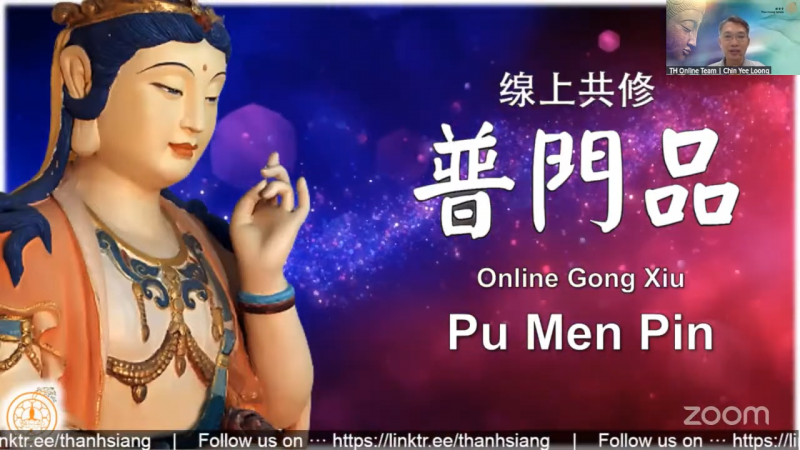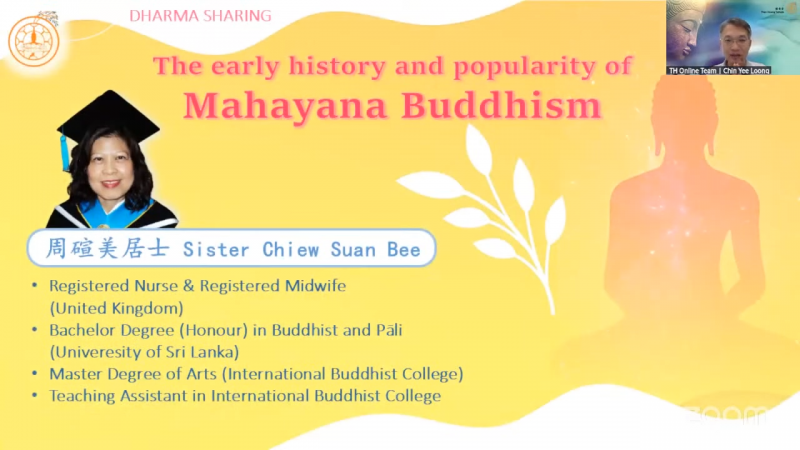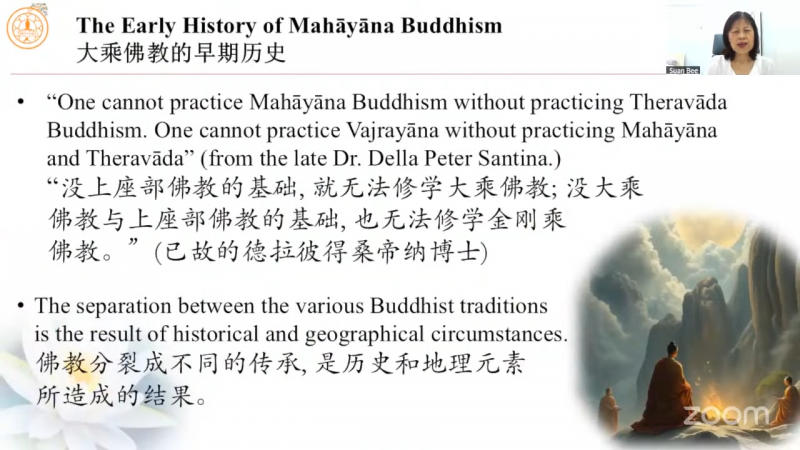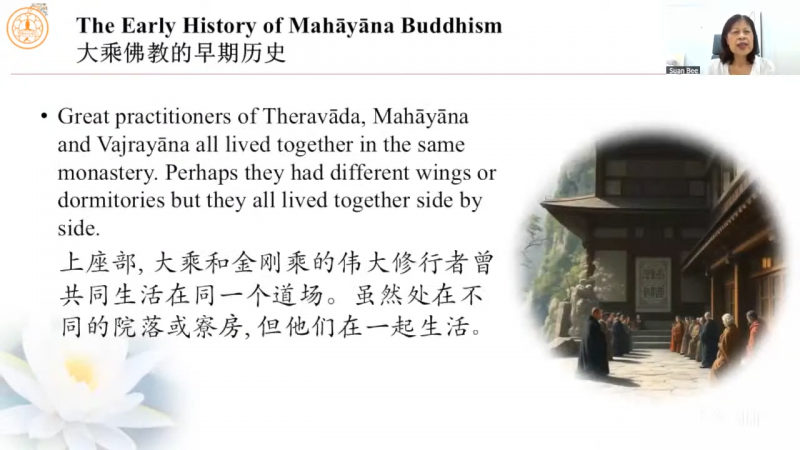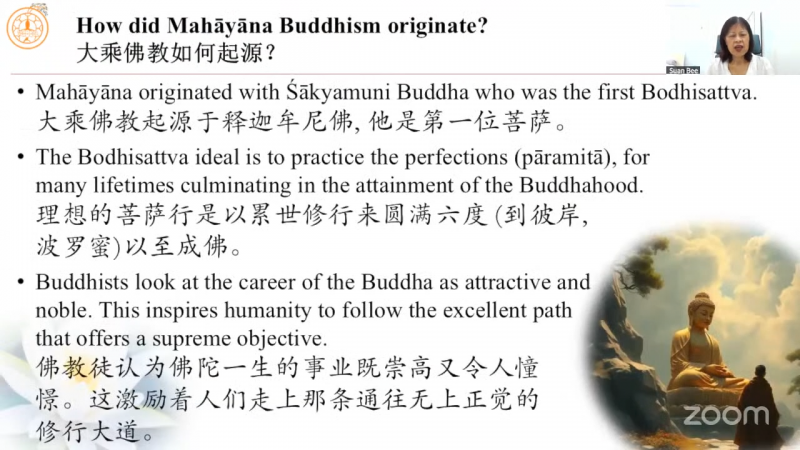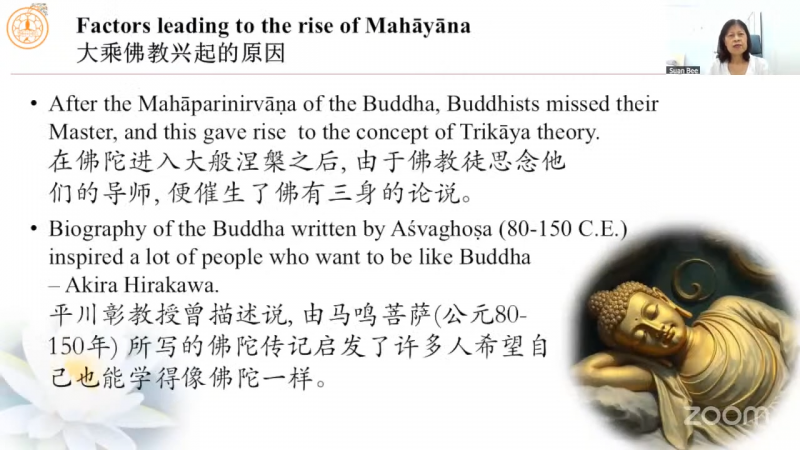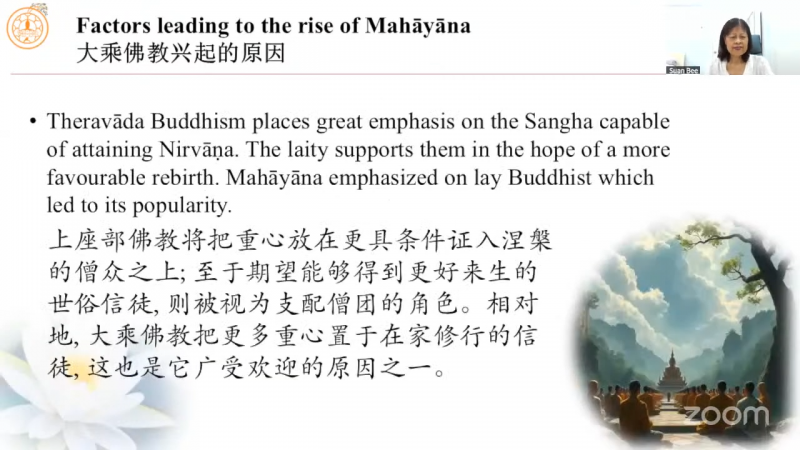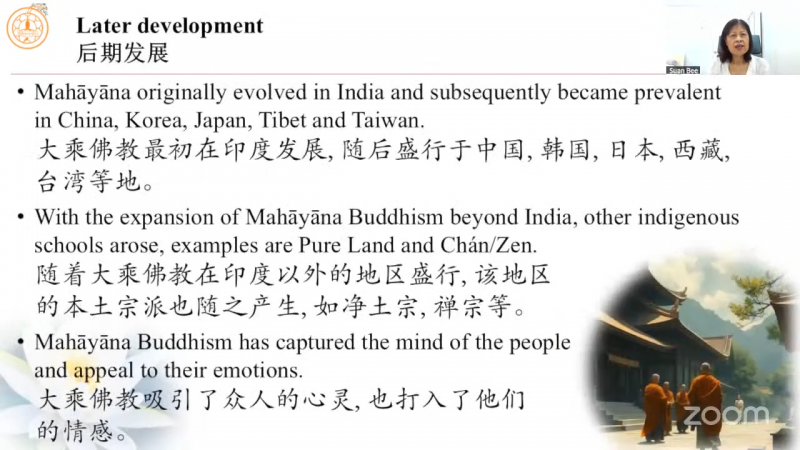Submitted by aier on

Than Hsiang's Pu Men Pin Online Gong Xiu’s Dharma Sharing(05/04/2025)
Teaching Assistant in International Buddhist College, Sister Chiew Suan Bee sharing “The early history and popularity of Mahayana Buddhism ”
The topic today is about “ The Early History of Mahāyāna Buddhism”
Before I start, I would like to explain the three traditions today: Theravāda, Mahāyāna and Vajrayāna ( or “ Tibetan Buddhism” if you like ).
Now, scholars had viewed Theravāda as the original teaching of the Buddha; Mahāyāna as a divergent school that split away from Theravāda; and Vajrayāna ( also known as Tantrayāna or “Tibetan Buddhism” if you like, because they actually employ Tantra in their practice). So these are the three traditions as mentioned today.
The late Dr. Della Peter Santina said : “ One cannot practice Mahāyāna Buddhism without practicing Theravāda Buddhism. And One cannot practice Vajrayāna without practicing Mahāyāna and Theravāda ”, and this is correct. When we practice Mahāyāna, we are also practicing Theravāda Buddhism, because Mahāyāna Buddhism is rooted in Theravāda. A rather it started from Theravāda, and Vajrayāna also shares the same common roots of Mahāyāna. They all follow the same fundamental doctrine of The Buddha, for example: The Law of Karma, Dependent Origination, Four Noble Truths, Noble Eightfold Path and so forth. And they also share the same goal, that is “ Enlightenment ” . And they also share the same founder—— Śākyamuni Buddha. So, there is no separation between them.
The separation between the various Buddhist traditions is the result of historical and geographical circumstances. And also of course there are some differences in their practice.
Great practitioners of Theravāda, Mahāyāna and Vajrayāna all lived together in the same monastery. Perhaps they had different wings or dormitories, but they all lived together side by side.
So, actually, in the travelogue of the Chinese pilgrim, they reported seeing Mahāyāna and non-Mahāyāna monks coexisting together in the same monastery. So, monks who were attracted to Mahāyāna teaching, they call themselves Mahāyāna. So, monks who followed the Theravāda teaching, they identified themselves as Theravādin. So, this is the way they identify, we can say this is the Self Identification process and they all live together.
How did Mahāyāna Buddhism originate? or What were the roots of Mahāyāna Buddhism?
Mahāyāna originated with Śākyamuni Buddha who was the first Bodhisattva.
In the Jataka story, we read many stories about Śākyamuni’s past life when he was a Bodhisattva, and there is a legend why he wanted to save all sentient beings. So, you may have heard of this legend before.
This is how the story goes:
In one of his former lives, he was born as a merchant. And He had to care for his blind mother.
One day, he had to go on a business trip, and there was no one to look after his mother. So, he decided to take her with him. They traveled by sea, and somewhere they encountered a storm and a shipwreck. So, He managed to find a plank to save his mother and managed to bring her to safety. So, this episode made him realize that he wants to save all sentient beings when he saw the suffering. So, the ocean, of course, I think you know, symbolizes “ Saṃsāra ” and saving his mother is the requisite for cultivating “Bodhicitta”. And the Bodhisattva made a vow that he wanted to liberate all sentient beings.
The Bodhisattva ideal is to practice the perfections (pāramitā), for many lifetimes culminating in the attainment of the Buddhahood.
So, one has to practice the “ Six Perfections ” and the “Bodhisattva Path” to Buddhahood; it is far from easy.
It is not easy.
Why?
Due to the act of Self-Sacrifice.
And the Bodhisattva Path to Buddhahood, one has to work endlessly for universal salvation; they do not despair. This is the core teaching of Mahāyāna.
Now, talking about Bodhisattva.
In Theravāda, this refer to Śākyamuni and Maitreya only.
In Mahāyāna, the Bodhisattva Path is not something new, because we have seen how Śākyamuni goes to the path.
So, What is new? and what is unique?
Now, is the idea that the Bodhisattva Path is applicable to anyone who wants to practice to become a “Buddha” as mentioned in The Lotus Sutra.
So, this also includes the Theravāda practitioner who did not reject this; they did not reject it. And many Theravādins are actually practicing this path today.
So, the Buddhists look at the career of the Buddha as attractive and noble. This inspires humanity to follow his excellent path that offers a supreme objective.
By the 1st century C.E., Mahāyāna Buddhism was in existence and prospered all over India and became very popular. So, the Bodhisattva Path is appealing, as you can see, no matter what the condition is, people favor it.
So, the arising of Mahāyāna follows the adoption of new sutras and introduction of new philosophies. Early Buddhism emphasize on wisdom and insight. Now Mahāyāna shifted to wisdom (prajña) and compassion (karunā).
Before Mahāyāna, the teaching of Theravāda focused on Vipassana meditation to gain “ Insight ” and “Wisdom”, and this is central in the Theravāda technique; But, with the change to Mahāyāna, the central teaching is “Wisdom” and “Compassion”.
Compassion is the keyword, leading to the Bodhisattva way of life. So here, it does not mean that Theravādin do not practice compassion, just that this is not emphasized as much as we see in Mahāyāna teachings.
Factors leading to the rise of Mahāyāna
Why Mahāyāna Buddhism become so popular?
After the Mahāparinirvāṇa of the Buddha, Buddhists missed their Master, and this gave rise to the concept of “ Trikaya ” theory.
The Buddha, as you all know, did not appoint a successor. So, it was quite natural for people who missed the Buddha to start making the Buddha into a permanent being.
The “Trikaya ” theory started, and this theory is purely a Mahāyāna concept. Distinctly Mahāyāna. And the theory says the Buddha has three bodies: “Trikaya”. So, it is hoped that the Buddha can remain in the form of Dhamma forever, and we call this the “Dhammakaya” . The second body is the “ Nirmanakaya ” of which is the body of transformation. And the “ Sambhogakaya ” is the body that experiences the place of Enlightenment. So, in this way, the Mahāyānis were able to create a permanent Buddha.
So, the next point is:
Why Mahāyāna rise so rapidly?
It is because of the biography of the Buddha written by Aśvaghosa (80-150 C.E.) . This book has inspired a lot of people who wanted to be like the Buddha. This statement was made by Akira Hirakawa, who is a Japanese poet and scholar. He was the one who said the book The Life of the Buddha inspired a lot of people who wished to practice to be a Buddha.
So, here it means the Bodhisattva Path is appealing no matter what sacrifices it takes.
Theravāda Buddhism places great emphasis on the Sangha capable of attaining Nirvāṇa. The laity supports them in the hope of a more favourable rebirth. Mahāyāna emphasized on lay Buddhist which led to its popularity.
We know that Theravāda Buddhism focuses on monastic life and the discipline of the monks, who pursue scholarly attainment. They have strict adherence to the rules and discipline of the Vinaya. In other words, Monastic life is the best way to achieve Nirvana. There are many people who are not able to follow this, especially in those days among the younger monks, as well as ladies and women. So, as a result of this, a movement started to bring Buddhism to the common people, and this is the one reason that makes Mahāyāna so attractive and popular. It has an inclusive attitude towards ladies and women.
So, many scholars say that this is a complementary, a compliment to Buddhism and it is not revolutionary.
This is one point that leads to the rise of Mahāyāna.
The worship of caityas ( caityas means a shrine ).
The worship of caityas is another reason. Lay people managed this, stay in temple and observe eight precepts. So Mahāyāna Buddhism developed into a “people-friendly-religion" which provide an opportunity for worship, faith, devotion and social interaction.
So, after the Buddha's demise, after the Buddha passed away, caityas represented the symbol of the Buddha. Lay people used to come to the temple, circumambulate, go around the caityas, pray, and they also engaged in a variety of ceremonies, sometimes meditation. This also started some interaction with the monks as well.
Actually, the job of looking after the caityas will done by the laity.
The Orthodox monk, they opposed to idol worship. We never see, we don't see idols during the early period in the history of Theravāda Buddhism. The Theravāda monks are also have no inclination towards rituals and ceremonies. So, in those days, Buddha was represented by symbols. If you can remember, for example: an umbrella, a footprint ( the footprint represents the Buddha ), or an empty seat.
There was no statue initially, so it was with the emergence of Mahāyāna Buddhism that the statue, a Buddha and Bodhisattva, started to emerge. We started to see the statues of Buddha and Bodhisattva around the 1st century CE in Northern India— Gandhara and Mathura. With the rise of Mahāyāna, this is another point.
Later development for Mahāyāna Buddhism
Mahāyāna originally evolved in India and subsequently became prevalent in China, Korea, Japan, Tibet and Taiwan. This is the northern part of the world, sometimes we call this “Northern Buddhism” or the “Greater Vehicle”.
With the expansion of Mahāyāna Buddhism beyond India, other indigenous schools arose; examples are Pure Land Buddhism and Chán (or “Zen” in Japanese). So, Chinese Buddhism has actually created these two new Mahāyāna schools: Pure Land and Chán.
Mahāyāna Buddhism has captured the minds of the people and appealed to their emotions.
The origination of Mahāyāna Buddhism is something that is historical.
By the first century, Mahāyāna teaching already existed and prospered all over India, especially in North India where Buddhism started and also in the South. South India has produced a lot of Mahāyāna scholars. The majority of them who went to Central Asia and China came from South India. And then there were also several kings who supported Mahāyāna Buddhism: the Kushan Empire of India — King Kanishka ( 4th Buddhist Council ), the Gupta and the Pala. The Gupta and Pala are the people who produced very nice statues of the Buddha and the Bodhisattva.
In China, we have the “Han” and the “Tang” Dynasties, who patronize Mahāyāna Buddhism.
And then in Indonesia, you may have heard of the Srivijaya Kingdom and the Sailendra Kingdom, who adopted Mahāyāna Buddhism.
So, in the development of Mahāyāna in India, Mahāyāna was actually influenced by Indian schools of thought like the Yogācāra, Madhyamaka, Sarvāstivāda, and a few other schools as well. There are many schools in India from which Mahāyāna arose.
Outside India, in China, for example, the indigenous traditions, like Taoism and Confucianism, are adopted; When we went to Tibet, it also adopted the “Bon”, which is the native religion of Tibet , and also incorporated various forms of Hinduism into Mahāyāna Buddhism.
Mahāyāna Buddhism has gone through many transformations, as we know, as well as development and modernization. It is not easy to stick to what was described 2,500 years ago, and we see today that Mahāyāna Buddhism has let us do the creation of the Tzu Chi Merit Society(慈济). Tzu Chi is a Mahāyāna school that focuses on Humanistic Buddhism, so this is an example of the new interpretation of the Buddha’s teachings in Mahāyāna, which is very appropriate to the current needs of the people today, which is the 19th and 20th centuries ( I think Tzu Chi developed around the 19th century). So this is the Mahāyāna Buddhism we see in how it started, developed, and transformed.
For more information, please browse https://youtu.be/ABiMMVJGOmg?si=eg8_3i6fWp9B5_S7
Spread the Buddha's teachings to guide more people to study Buddhism.
Continue diligently in the path studying the Buddha's teachings and listening to the Dharma.
Follow us on:
https://linktr.ee/thanhsiang
